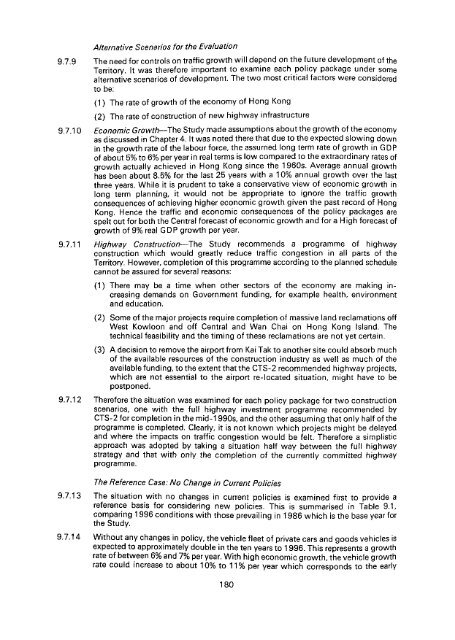Untitled - HKU Libraries - The University of Hong Kong
Untitled - HKU Libraries - The University of Hong Kong
Untitled - HKU Libraries - The University of Hong Kong
- No tags were found...
You also want an ePaper? Increase the reach of your titles
YUMPU automatically turns print PDFs into web optimized ePapers that Google loves.
Alternative Scenarios for the Evaluation9.7.9 <strong>The</strong> need for controls on traffic growth will depend on the future development <strong>of</strong> theTerritory, it was therefore important to examine each policy package under somealternative scenarios <strong>of</strong> development. <strong>The</strong> two most critical factors were consideredto be:(1) <strong>The</strong> rate <strong>of</strong> growth <strong>of</strong> the economy <strong>of</strong> <strong>Hong</strong> <strong>Kong</strong>(2) <strong>The</strong> rate <strong>of</strong> construction <strong>of</strong> new highway infrastructure9.7.10 Economic Growth—<strong>The</strong> Study made assumptions about the growth <strong>of</strong> the economyas discussed in Chapter 4. It was noted there that due to the expected slowing downin the growth rate <strong>of</strong> the labour force, the assumed long term rate <strong>of</strong> growth in GDP<strong>of</strong> about 5% to 6% per year in real terms is low compared to the extraordinary rates <strong>of</strong>growth actually achieved in <strong>Hong</strong> <strong>Kong</strong> since the 1960s. Average annual growthhas been about 8.5% for the last 25 years with a 10% annual growth over the lastthree years. While it is prudent to take a conservative view <strong>of</strong> economic growth inlong term planning, it would not be appropriate to ignore the traffic growthconsequences <strong>of</strong> achieving higher economic growth given the past record <strong>of</strong> <strong>Hong</strong><strong>Kong</strong>. Hence the traffic and economic consequences <strong>of</strong> the policy packages arespelt out for both the Central forecast <strong>of</strong> economic growth and for a High forecast <strong>of</strong>growth <strong>of</strong> 9% real GDP growth per year.9.7.11 Highway Construct/on—<strong>The</strong> Study recommends a programme <strong>of</strong> highwayconstruction which would greatly reduce traffic congestion in all parts <strong>of</strong> theTerritory. However, completion <strong>of</strong> this programme according to the planned schedulecannot be assured for several reasons:(1) <strong>The</strong>re may be a time when other sectors <strong>of</strong> the economy are making increasingdemands on Government funding, for example health, environmentand education.(2) Some <strong>of</strong> the major projects require completion <strong>of</strong> massive land reclamations <strong>of</strong>fWest Kowloon and <strong>of</strong>f Central and Wan Chas on <strong>Hong</strong> <strong>Kong</strong> Island. <strong>The</strong>technical feasibility and the timing <strong>of</strong> these reclamations are not yet certain.(3) A decision to remove the airport from Kai Tak to another site could absorb much<strong>of</strong> the available resources <strong>of</strong> the construction industry as well as much <strong>of</strong> theavailable funding, to the extent that the CTS-2 recommended highway projects,which are not essential to the airport re-located situation, might have to bepostponed.9.7.12 <strong>The</strong>refore the situation was examined for each policy package for two constructionscenarios, one with the full highway investment programme recommended byCTS-2 for completion in the mid-1990s, and the other assuming that only half <strong>of</strong> theprogramme is completed. Clearly, it is not known which projects might be delayedand where the impacts on traffic congestion would be felt. <strong>The</strong>refore a simplisticapproach was adopted by taking a situation half way between the full highwaystrategy and that with only the completion <strong>of</strong> the currently committed highwayprogramme,<strong>The</strong> Reference Case: No Change in Current Policies9.7.13 <strong>The</strong> situation with no changes in current policies is examined first to provide areference basis for considering new policies. This is summarised in Table 9.1,comparing 1996 conditions with those prevailing in 1986 which is the base year forthe Study.9.7.14 Without any changes in policy, the vehicle fleet <strong>of</strong> private cars and goods vehicles isexpected to approximately double in the ten years to 1996. This represents a growthrate <strong>of</strong> between 6% and 7% per year. With high economic growth, the vehicle growthrate could increase to about 10% to 11% per year which corresponds to the early180
















